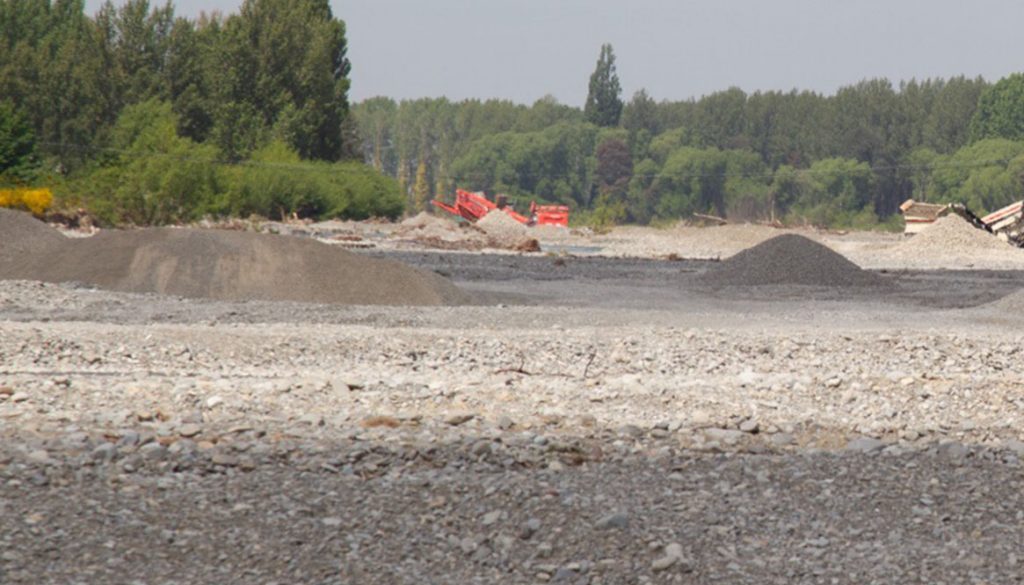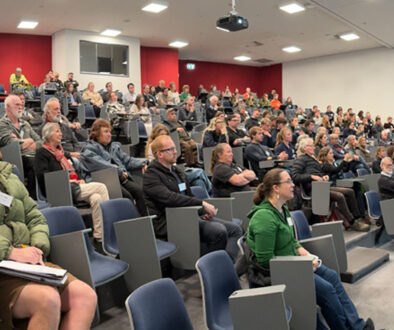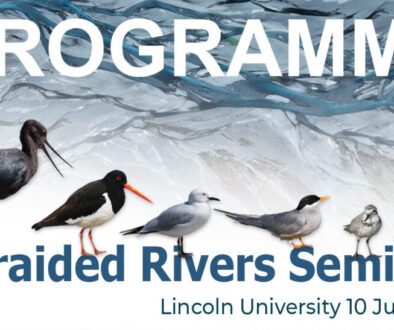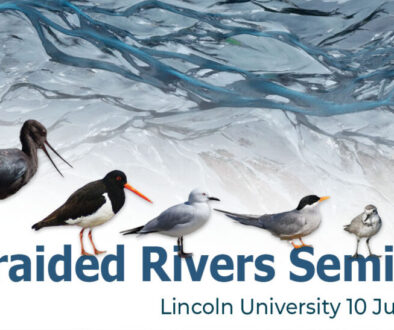Mining braided rivers
It is essential that gravel mining sites are returned to a natural braided state after operations cease.
Image: Grant Davey.
Context
Braided rivers are some of the most biologically productive and rare ecosystems on Earth. In Canterbury, they formed during the Quaternary Period when glaciers bulldozed through the Southern Alps, their ephemeral waterways carving out wide alpine valleys and carrying large amounts of gravel from glacial moraines to the shallow ocean at the coast. Over 2.5 million years, the sediments and gravels fanned out across braidplains, coalescing into mega alluvial fans that today we call the Canterbury and Amuri Plains. Dynamic ecosystems evolved, adapting to this extraordinary and ever-changing environment. We know this because of the widespread geomorphological evidence[1].
We also know that these braidplains provided numerous irreplaceable life-supporting ecosystem services, otherwise known as critical natural infrastructure. The sediment they delivered to coastal lands counteracted the erosive forces of wind-driven waves and storm surges. Permanent wetlands acted as kidneys, cleaning waterways and drawing carbon dioxide from the atmosphere and storing it in their peaty soils. Ephemeral wetlands played a role too, acting as sponges, absorbing floodwaters and calming their destructive tendencies. In the diverse braidplain ecosystems that formed, and with the assistance of microbial, fungal, and invertebrate communities, water was filtered and nutrients cycled, enabling and supporting unique and endemic aquatic and terrestrial biodiversity. For the early human inhabitants of Aotearoa New Zealand, braided rivers provided plentiful and safe drinking water and mahinga kai; natural infrastructure that enabled them to thrive.
Without natural infrastructure and the ecosystem services and resources that braided rivers provide, there can be no built infrastructure. The reverse is not the case. Thus, natural infrastructure is a first order human necessity over built infrastructure, and—unlike built infrastructure—natural infrastructure is provided free of charge.
Ironically, failing to recognise braidplains as critical natural infrastructure has now put critical built infrastructure[2]—along with farms, businesses, and indeed entire towns—at huge risk. One prominent risk, flooding, was identified in 2019 in NIWA’s extraordinarily well-ignored report, which concluded than the level of exposure of built elements at risk within Canterbury’s flood hazard area to be $40 billion (based on 2016 valuations)[3]. The rivers’ waters are polluted, costing ratepayers to clean it to standards that fall below the World Health Organisation’s recommendations[4]. What mahinga kai remains—a mere fraction of historical levels—is tainted. Some endemic bird and fish species integral to maintaining healthy ecosystem services are near extinction. Coastal ecosystems that could have acted as buffers to rising sea levels and storm surges are now starved of the sediments the rivers once delivered along coastal margins. This is in part due to water harvesting for irrigation:
“The conventional wisdom is that you harvest flood water in the winter and store it until it’s needed (for agriculture) in the summer. However, floods are required to carry gravels to the coastal zone and if there’s not enough gravel, the waves get hungry and start eroding the land.” – Dr Scott Lanard, NIWA[5]
And in part because the once wide braidplains have been forced into ever-narrowing spaces. During high water flows, the constricted fast-flowing rivers shoot lighter sediments and gravels out into ocean waters too deep for beach-building waves to return to the shore[6].
Importantly, these are not the ‘opinions of a few’, but rather, grounded in peer-reviewed science[7], on research and investigations that Environment Canterbury (ECan) has commissioned[8], and on facts supported by empirical evidence1-9.
We applaud the efforts of those at ECan who have presented unequivocal evidence that braidplains and their rare, life-supporting ecosystems continue to be destroyed. And we support their hard mahi as they endeavour to navigate outdated and often conflicting legislation and equally conflicting values in a rapidly changing climate.
When it comes to gravel extraction, rivercare groups, most notably the Ashley Rakahuri Rivercare Group (ARRG) have supplied robust data and evidence[9] that gravel extraction consenting processes in their current form do not consistently adhere to ECan’s stated goals in the Canterbury Water Management Strategy (CWMS): to ‘protect and restore the natural character of braided rivers’. Further, that by 2025—a mere three years from now—‘Five priority braided rivers are under active management to increase habitat area usable by all species of indigenous braided river birds.’[10] Birds are not simply nice to have; they are bioindicators of the health of critical natural infrastructure.
The Ashley Rakahuri River is one of these stated ‘active management areas’. Over the last two years, ARRG’s concern about riverbed management and gravel extraction has been expressed to ECan on a number of occasions, but significant changes in operational management have yet to see the light of day. Meanwhile, consents for gravel extraction have been issued with little regard for natural character, biodiversity, and mahinga kai values, and without due consideration of climate-related risks, including the risk of maladaptation:
“There is increased evidence of maladaptation across many sectors and regions since the AR5. Maladaptive responses to climate change can create lock-ins of vulnerability, exposure and risks that are difficult and expensive to change and exacerbate existing inequalities.” – IPCC AR6 WGII [11]
The points above are critically important and need inclusion in the pending review of ECan’s Gravel Management Strategy.
Environment Canterbury Catchment Sub-committee
This committee is the major link between ECan and gravel extractors and therefore has significant influence on braided river management. One of the Catchment Sub-committee’s Purposes is to:- To have regard to the philosophy of ki uta ki tai—from the mountains to the sea—across its streams, lake, wetlands, estuaries, waterways, coastline, biodiversity and water supplies and to the importance and unique characteristics of braided rivers.
- Ensure that the Sub-committee’s activities:
- Take into account climate-change related risks; and
- are consistent with Council’s plans and initiatives to give effect to Council’s declaration of a climate emergency on 16 May 2019.
- That ECan should seriously investigate how much the flow capacities of rivers can be improved;
- That the costs of consents imposed on gravel extraction businesses should be reduced by reducing the conditions associated with consents; and
- That ECan and Road Metals ensure that other affected parties (Department of Conservation, LINZ, and NGOs including Birds NZ, Forest & Bird, and river care groups), which Road Metals opine already have too much control and influence at a ’higher level’, do not have the current level of influence, and specifically that: ‘‘ECan needs to take back control of being able to manage the rivers in the best interests of all their ratepayers and taxpayers within Canterbury [and that] “Infrastructure must be prioritised to ensure that community needs ‘outweigh the opinions of a few’.”
“The Commission recommends that the Government creates a climate-resilience agency… The new entity should also assist regional councils and communities consider the best way to lessen future risk of flooding from rivers. This would include, where appropriate, the potential for using the best-practice model of giving rivers room and developing multiple innovative uses of the wider river corridors.” [16]
“Healthy functional ecosystems help reduce climate change vulnerability and disaster risk by reducing physical exposure to hazard, by serving as protective barriers or buffers and so mitigating hazard impacts.
“Ecosystem-based adaptation (EbA) should be integrated into broader adaptation and development strategies to maintain and increase resilience and reduce vulnerability of ecosystems and people to adverse effects of climate change.
“Ecosystem-based disaster risk reduction includes managing ecosystems to complement, protect and extend the longevity of investments in hard infrastructure.”[18]
References
[1] 2018: NIWA; Braidplain delineation methodology, Prepared for Environment Canterbury: http://braidedrivers.org/wp-content/uploads/Braidplain-delineation-methodology.pdf
2003: Browne & Naish; Facies development and sequence architecture of a late Quaternary fluvial-marine transition, Canterbury Plains and shelf, New Zealand: implications for forced regressive deposits. Sedimentary Geology 158, Issues 1–2, pp57-86
2008: Forsyth et al; Geology of the Christchurch Area, GNS Science, 67 pages.
See also: http://braidedrivers.org/braidplains/
[2] As defined by the National Emergency Management Agency: https://www.civildefence.govt.nz/assets/Uploads/lifelines/nzlc-nva-2020-full-report.pdf
[3] 2019; Paulink et al; New Zealand Fluvial and Pluvial Flood Exposure, NIWA client report no: 2019118WN /National Science Challenges: https://climateandnature.org.nz/wp-content/uploads/2020/05/NIWA-Flood-Exposure.pdf
[4] For a recent overview see Summer Science: There’s something in the water – Radio NZ, https://www.rnz.co.nz/national/programmes/ourchangingworld/audio/2018816209/summer-science-there-s-something-in-the-water
2022: Chambers et al; Nitrate in drinking water and cancer risk: the biological mechanism, epidemiological evidence and future research, Australian and New Zealand Journal of Public Health: https://onlinelibrary.wiley.com/doi/10.1111/1753-6405.13222
[5] 2021; in Pepperell; The Future Shape of Water in Water and Atmosphere, 11 February, https://niwa.co.nz/news/the-future-shape-of-water
[6] 1995: Dunns; A sediment budget analysis of Pegasus Bay. MSc thesis, University of Canterbury
1987: Blake & Mosley; Impact of the Waimakariri River control scheme on the river and its environment, National Water and Soil Conservation Authority Water and Soil Directorate, Ministry of Works and Development.
1998: Hicks, Sediment budgets for the Canterbury Coast – a review, with particular reference to the importance of river sediment. Unpublished consultancy report No. CRC80506 to the Canterbury Regional Council. 83pp.
2008: Hilton & Nicol; Offshore sand systems: geomorphology and management. Chapter 5 in The New Zealand Coast. Palmerston North: Dunmore Press. 312pp
1984: Wright & Short; Morphodynamic variability of surf zones and beaches: A synthesis. Marine Geology 56. pp 93-118.
[7] Op cit. See also:
2022: IPCC Sixth Assessment Report; Working Group II contribution to the Sixth Assessment Report, Climate Change 2022: Impacts, Adaptation and Vulnerability: https://www.ipcc.ch/report/sixth-assessment-report-working-group-ii/
2021: IPCC Sixth Assessment Report; Working Group I contribution to the Sixth Assessment Report, Climate Change 2021: The Physical Science Basis: https://www.ipcc.ch/assessment-report/ar6/
2021: Ministry for the Environment; First national climate change risk assessment for New Zealand, https://environment.govt.nz/what-government-is-doing/areas-of-work/climate-change/adapting-to-climate-change/first-national-climate-change-risk-assessment-for-new-zealand/
https://climateandnature.org.nz/climatefaqs/canterbury-climate/
https://climateandnature.org.nz/our-places/rivers/
[8] See for example: 2021: Grove et al; Agricultural land use change in mid-Canterbury hill and high country, 1990- 2019: implications for indigenous biodiversity and ecosystem health: http://braidedrivers.org/wp-content/uploads/AgriculturallandusechangeinmidCanterburyhillandhighcountry19902019implicationsforindigenousbiodiversityandecosystemhealth.pdf
2021: Greenep and Parker; Land use change on the margins of lowland Canterbury braided rivers, 2012-2019: Land use change on the margins of lowland Canterbury braided rivers, 2012-2019
[9] BRaid seminar14 July, 2022; Davey; The plight of the foothills-fed Canterbury braided rivers, http://braidedrivers.org/wp-content/uploads/Davey-BRaid-Seminar-2021.pdf
[10] https://www.ecan.govt.nz/your-region/plans-strategies-and-bylaws/canterbury-water-management-strategy/
[11] 2022: IPCC Sixth Assessment Report; Working Group II contribution to the Sixth Assessment Report, Climate Change 2022: Impacts, Adaptation and Vulnerability: Summary for Policymakers https://report.ipcc.ch/ar6wg2/pdf/IPCC_AR6_WGII_SummaryForPolicymakers.pdf
[12] Stationarity: https://climateandnature.org.nz/our-places/rivers/#f
[13] 2008: Milly et al; Stationarity Is Dead: Whither Water Management? Science 319 | 5863, pp573-574
[14] 2022: IPCC Sixth Assessment Report; Working Group II contribution to the Sixth Assessment Report, Climate Change 2022: Impacts, Adaptation and Vulnerability: https://www.ipcc.ch/report/sixth-assessment-report-working-group-ii/
2021: IPCC Sixth Assessment Report; Working Group I contribution to the Sixth Assessment Report, Climate Change 2021: The Physical Science Basis https://www.ipcc.ch/assessment-report/ar6/
[15] 2021: Brierley et al; Why we should release New Zealand’s strangled rivers to lessen the impact of future floods, The Conversation
2004: Ashworth et al; Relationship between sediment supply and avulsion frequency in braided rivers. Geology 32: https://www.researchgate.net/publication/252781507_Relationship_Between_Sediment_Supply_and_Avulsion_Frequency_in_Braided_Rivers
[16] https://climateandnature.org.nz/wp-content/uploads/2021/05/ProdCom_Draft-report_Local-government-funding-and-financing.pdf
[17] 2020: Richardson and Fuller; Quantification of channel planform change on the lower Rangitikei River, New Zealand, 1949-2007: response to management? https://mro.massey.ac.nz/handle/10179/1618 and
2003: Surian and Rinaldi; Morphological response to river engineering and management of alluvial channels in Italy. Geomorphology 50 (2003) 307 – 326. https://www.sciencedirect.com/science/article/abs/pii/S0169555X02002192 and
2005: Kelly, McKerchar, and Hicks; Making concrete: ecological implications of gravel extraction in New Zealand rivers. Water & Atmosphere 13(1) 2005. https://niwa.co.nz/publications/wa/vol13-no1-march-2005/making-concrete-ecological-implications-of-gravel-extraction-in-new-zealand-rivers and
1997: Kondolf; Hungry Water: Effects of Dams and Gravel Mining on River Channels. Environmental Management. 21. 533-551 https://link.springer.com/article/10.1007/s002679900048
[18] 2016: UNEP Convention on Biological Diversity; Synthesis Report on Experiences with Ecosystem-Based Approaches to Climate Change Adaptation and Disaster Risk Reduction, CBD Technical Series No. 85: https://www.cbd.int/doc/publications/cbd-ts-85-en.pdf




